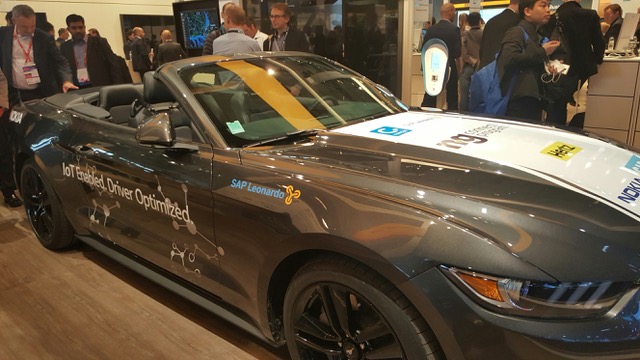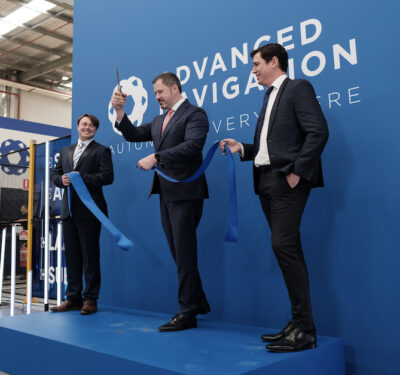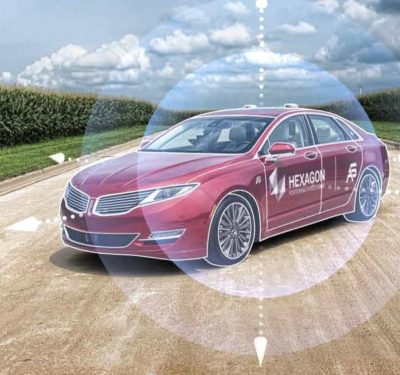
Hertz is partnering with several companies on in-vehicle telematics (photo courtesy: Kevin Dennehy)
BARCELONA—While basic navigation maps allow drivers to turn right or left, vision is by far the car’s most dominate sensor, particularly as autonomous vehicles hit the road, said Alex Mangan, HERE head of product marketing, automotive, at a Mobile World Congress autonomous vehicle panel.
“Why have a [digital] map? A car’s LiDAR, radar, cameras and other sensors can define its immediate vicinity,” he said. “However, vision alone has its limits. Sensors, limited by physics, can’t see through a truck in front of it, or if a lane has been closed.”
Mangan said a car also has about 5 to 10 kilometers to assess traffic. “A high-definition map solves three problems for autonomous vehicles. Where am I? What lies ahead? What happens around the curve?” he said.
Some other solutions a digital map brings to the autonomous vehicle world are the defining what are the lanes, their width, borders and centerline. “The second critical element is to find objects, to centimeter-precision, of what lies ahead. That’s the most important,” he said.
Mangan said that how a car reacts to a sudden lane closure or traffic jam is important as the autonomous vehicle needs to look what’s beyond the range of embedded car sensors. “These problems that need to be solved are, how do I get there comfortably? Do I drive differently around a sharp curve, when it’s raining?” he said.
Mangan said HERE is working with BMW and Mobileye to share data to close the sensor feedback loop. “We get the information in the cloud to get sensor data to help us maintain it, then the loop closes. It’s active rather than reactive,” he said. “Without sharing data across OEMs, self-driving won’t be possible. There are too many geography, technology and sensor data challenges”
Autonomous Trucks Big in Europe
Automated driving, first coming in the form of platooning, will be critical to the trucking industry in Europe, said Daniela Gerd tom Markotten, who runs the digital solutions and services unit of Mercedes-Benz trucks, said that automated driving is important to the trucking industry.
“Logistics and transportation are huge. In Europe, 75 percent of all transport is done by trucks. About 3 million people work in the road freight industries,” she said. “It’s the backbone of our society. No trucks, no goods, no jobs, no food.”
She said that by 2050, transportation volume will tripled, but the road network won’t be. “Waiting and standing time, traffic jams, rest areas fully booked and one out of every four trucks unloaded. Market research 2050 transportation volume will be tripled, road network won’t be. If you look at the daily lives of truck drivers, it involves waiting, loading, unloading and administration.”
She says if all trucks are connected, then companies will have better insight on why delays happen. “By 2020, 35 million trucks will be connected, have telematics, digital solutions, platooning and autonomous driving,” she said.
She said that platooning can save fuel, reduce driving to increase safety. “The first truck operates autonomously as well as the second and third,” she said.
Airbiquity and STMicroelectronics Team on Telematics Device
At MWC, Airbiquity and STMicroelectronics said they are integrating Airbiquity’s software and data management offering into ST’s evaluation board telematics processor. The joining of technology highlights the interoperability between Airbiquity’s cloud-based service delivery capability and ST’s onboard Telemaco3 plaform, said David Jumpa, Airbiquity chief revenue officer.
“From our perspective, this relationship with ST is the biggest driver for software data management. It brings more standardized cyber security, warranty avoidance monitoring, car data collection capability to fix issues,” he said.
In the future, Airbiquity’s autonomous driving initiatives will focus on [vehicle-to-infrastructure], traffic, rerouting and a lot of connectivity, Jumpa said.






